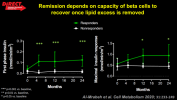harbottle
Well-Known Member
- Relationship to Diabetes
- Type 2
There’s an argument that all T2s should have tests for IR and c-peptide, in order to determine ‘phenotype’ and find a better treatment. (i.e. high IR, low beta cell functionality, high IR and normal beta cell function, and low IR but deficient insulin production.)
I’d be happy to get a high c-peptide result (And low IR) as it means removing insulin resistance would its possible to reverse the condition.
’Classic Type 2’ is a low insulin production and high insulin resistance. I wouldn‘t be so happy with this, as reversal is not as clear cut and it means a degree of beta cell dysfunction which may or may not be reversable. (I suspect I am in this boat, though.)
The other type is ’low insulin production’ and low/no insulin resistance. This is normally ‘slim’ type 2s, which wasn’t me, as I was somewhat rotund upon diagnosis!
I’d be happy to get a high c-peptide result (And low IR) as it means removing insulin resistance would its possible to reverse the condition.
’Classic Type 2’ is a low insulin production and high insulin resistance. I wouldn‘t be so happy with this, as reversal is not as clear cut and it means a degree of beta cell dysfunction which may or may not be reversable. (I suspect I am in this boat, though.)
The other type is ’low insulin production’ and low/no insulin resistance. This is normally ‘slim’ type 2s, which wasn’t me, as I was somewhat rotund upon diagnosis!


